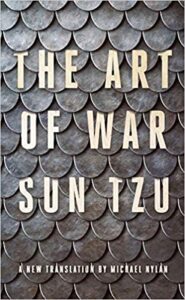Headlines
Allen Boyer: Review of “The Art of War” by Sun Tzu – A New Translation by Michael Nylan
“Do not attack an enemy who has the high ground.
“Do not go against an enemy who has his back to a hill.
“Do not follow an enemy that feigns retreat.
“Do not attack the enemy’s crack troops.
“Do not stop an army on its way home.
“When surrounding an enemy, leave him a way out.”
“The Art of War,” from which these precepts come, is the first surviving discussion of military strategy. For more than two thousand years, it has offered advice – told readers flat-out what to do, puzzled them with cryptic comments, and repaid its best students with victory.

“The Art of War” by Sun Tzu.
Like most ancient wisdom literature, “The Art of War” took shape over time. The book is credited to a legendary general, Sun Tzu, also called Sunzi or Sun Wu, who lived in the late sixth century BC (just before the Athenians defeated the Persians at Marathon). Sun Tzu is said to have created a new school of warfare. Instead of letting noblemen skirmish in chariots, he pressed charges home with serried ranks of infantry, peasant soldiers who “dared to die” in order to win battles.
By the first century BC, the book had taken its present form. In 1972, Chinese archaeologists removed from a tomb site a manuscript that included the chapters of the present text.
Michael Nylan, the translator of this edition, writes: “The text urges upon its followers the notion than it is better to outthink the enemy than to fight him.” This outlook, she suggests, has won “The Art of War” popular with both military academies and business schools. Particularly influential was the 1963 translation by Marine general Samuel B. Griffith, who had seen the Chinese civil war of 1947-49 and earned a doctorate in military history at Oxford. Donald Trump has tweeted quotations from “The Art of War.” Across the aisle, a Democratic Congressman has flattered Nancy Pelosi by introducing her with a quotation from Sun Tzu.

Michael Nylan.
The book was written to instruct. Some of its teachings rhyme so that they may be remembered (and for the Chinese verses, Nylan ably finds English equivalents).
“With fire’s help, attack – and guide its course.
With water’s help, attack – and wield its force.
Water can cut the foe off, true.
But will not seize his goods for you.”
Some lines speak with the authority of a veteran combat scout. “Wherever birds gather, the enemy position is unoccupied.” Or it may be a shrewd commander who speaks: “When his officers are easily angered, the enemy is exhausted.”
“In crossing perilous salt marshes,” Sun Tzu advises, “the key thing is to rush through and brook no delay.” Napoleon would have seen in that something like his warning that the fifth element consists of mud. The young Napoleon could have read “The Art of War”; a French translation had been published in 1772.
If this advice is direct and literal, Sun Tzu can offer wisdom in the riddle-like shape of a Zen koan: “It is you who determine your own invincibility, but whether the enemy can be conquered or not rests with him.” “If you know neither the enemy nor yourself, you will lose every battle.”
In 1949, when Mao Zedong’s infantrymen closed in on Shanghai, the Communists struck toward the downtown, then pulled away, drawing the Nationalist garrison into a fight in the outskirts. The end of the battle came not with a sudden mass attack, but with an explosion in the defenders’ central arsenal: fire and explosion rocking the darkness, while Nationalist soldiers ran aboard freighters, fleeing for Taiwan. Careful advances, feigned retreats, fighting with fire, letting the enemy flee – Sun Tzu’s precepts may still set the rhythm of modern conflict.
This version of “The Art of War” may be the first translation by a woman. Nylan teaches early Chinese history at Berkeley; she has previously written on Confucius and the historian Sima Qian, and here has drawn on the resources of a working group that includes a poet and a former military officer. To the text of “The Art of War,” the author adds a provocative discussion of the work’s history, including the debate over whether the closing chapters teach the value of peace.
“The Art of War” By Sun Tzu – A New Translation by Michael Nylan. W.W. Norton & Company. 157 pages. $24.95.
Allen Boyer is the book editor of HottyToddy.com. The author of “Rocky Boyer’s War,” he is currently at work on the history of the law of treason.





























